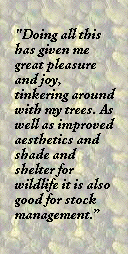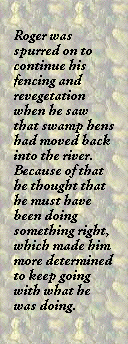
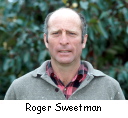

Roger's parents purchased their property on Hunwick Road in 1960 and they began clearing it immediately, finishing in about 1980. The original vegetation on the riparian flats was paperbark (Melaleuca), Albany bottlebrush (Callistemon speciosus), tea tree (Leptospermum) and sedges. The 203 hectare property is near the top of the Sleeman River catchment and the river runs through the property in a southwesterly direction on its way to the Wilson Inlet. Roger has lived on the property all his life and has farmed cattle during that time.
Roger's first foray into conservation occurred when he asked his father not to burn the heaps of windrow timber in one of the paddocks but to leave them for future generations for firewood. He also persuaded his father to allow a patch of cleared bush to regenerate. He subsequently fenced this area off to exclude stock to enable the understorey to come back.
The Problem
During the 1980s Roger became concerned that the cattle were getting into the riparian area knocking down and trampling all the young paperbarks, tea trees and rushes. They were also polluting the river with their droppings.
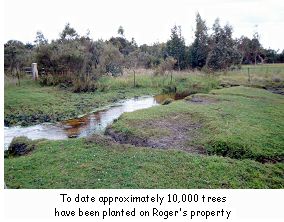 The Solution
The Solution
Roger began fencing and revegetation of the river to:
- keep the river clean
- look after the soil
- improve economic return
- encourage birds and other wildlife back into the area
Fencing and revegetation of the river was started by Roger in 1987 and continued up until 1992. It took four consecutive winter-spring plantings to complete the program. He has experimented with various methods of fencing in different areas. Areas for revegetation were fenced to exclude kangaroos and rabbits and areas for regeneration were fenced with a single hot wire at knee height to exclude cattle. A total of 1.5 kilometres of fencing has been erected along the Sleeman River. In addition Roger has just finished fencing off a permanent pool on the property that will be allowed to regenerate naturally.
Along the river the fences were built by following the riverbank contour and buffers up to 30 metres wide were created on either side of the river. Roger believed that the bigger the buffer the less likelihood that runoff containing superphosphate fertiliser would find its way into the river during winter.
He then hand-planted trees that "liked to get their feet wet and could handle copious amounts of water", including swamp gum Eucalyptus ovata, swamp mahogany E. robusta, eastern flooded gum E. grandis, Sydney blue gum E. saligna and western flooded gum E. rudis. After fencing many of the original native species such as paperbark, Albany bottlebrush, tea tree, sedges and rushes, including the jointed twig rush (Baumea articulata) have regrown. To date approximately 10,000 trees have been planted on the property.
A grant for fencing the left side of the river was obtained from the Water and Rivers Commission during 1995.
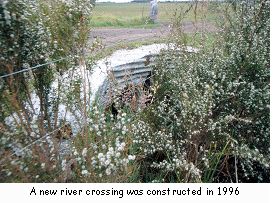 The Outcomes and Observations
The Outcomes and Observations
"You can most definitely see the effects of the revegetation visually. Instead of being smashed about by the animals its starting to blossom out and block the light so it's just a long winding sea of green. That tells me that all the stuff is starting to canopy out and fill all the holes up, which is just what I want".
"Doing all this has given me great pleasure and joy, tinkering around with my trees. As well as improved aesthetics and shade and shelter for wildlife it is also good for stock management. Now the river is fenced I can always find them, especially cows giving birth. It's also a good buffer for heavy water runoff, its good shelter for a biting cold, windy day or a stinking hot summer day for the stock. The benefits are just endless".
"The bottom line would have to be also a monetary value, the price of the property can only improve. If you are farmer that's heavily into constructive tree planting and revegetation of your most precious asset, which is water, I'm sure common sense would dictate that the price of your plot of land would have to be a little more than some of the other fellow farmers".
Roger was spurred on to continue his fencing and revegetation when he saw that swamp hens had moved back into the river. Because of that he thought that he must have been doing something right, which made him more determined to keep going with what he was doing. It was about that time that he decided to "go native" with tea tree, bottlebrush and paperbark in other different areas.
"You wake up in the morning here and the chatter of the birds in the trees is just a buzz. There's no lovelier sound, I don't believe, to wake up to on a farm hearing the birds in full chorus".
After visiting a cousin in the eastern states Roger discovered that some of the trees he had planted to soak up excess water on the flats were also the diet of koalas. He is now interested in keeping koalas on his farm.
To further protect the river a new crossing for vehicles and cattle was completed in 1996. There was an old wooden bridge at the site previously and scouring had taken place around the sides during floods, so Roger replaced it using two concrete pipes under a gravel-filled base. This has proven to be stable, with no signs of erosion so far.
Although there has not been a flood since the crossing was constructed Roger is confident that it will withstand flood conditions. Roger said he would use smaller diameter pipes so as to lower the height of the crossing if he were to construct another one.
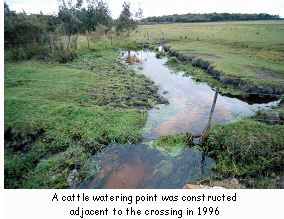 A cattle watering point was also constructed adjacent to the crossing during 1996. A V-shaped indentation was made in the fence to allow cattle a small access point on the river to obtain water. There has been some erosion of the bank due to cattle trampling but the watering point has been largely successful. It is intended that the exposed bank will be stabilised using large gravel rocks placed singly in a row and cemented in place.
A cattle watering point was also constructed adjacent to the crossing during 1996. A V-shaped indentation was made in the fence to allow cattle a small access point on the river to obtain water. There has been some erosion of the bank due to cattle trampling but the watering point has been largely successful. It is intended that the exposed bank will be stabilised using large gravel rocks placed singly in a row and cemented in place.
In addition to the wildlife returning, the riverbanks are now stable and the water is clear. However the jointed twig rush has regrown so prolifically that Roger is now concerned that it is "choking" the river and slowing down the flow to such an extent that increased flooding is occurring in some of the paddocks. In addition, one of the feeder drains that flow into the river is now full of jointed twig rush and although the water still gets through Roger believes it doesn't get through as well as it used to. The feeder drain has been dug out twice to clean out the silt and rushes; this seems to keep the water flowing through more efficiently.
Overall Roger believes that the positives of his conservation work has far outweighed any negatives and that: "You need to keep a balanced view of the argument. In any situation there has to be a positive and a negative and you've got to find a happy medium. You can't get too blasé about it but you can't go ultra green".
Sleeman River Catchment Statistics
| Type of watercourse: | Perennial river | |
| Rainfall: | 700-800 mm./year | |
| Water quality: | Fresh | |
| Catchment disturbances: | Cattle grazing, cropping |
